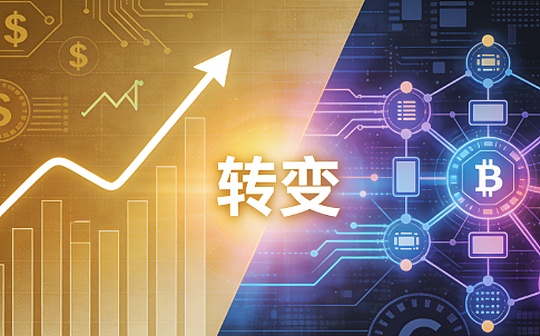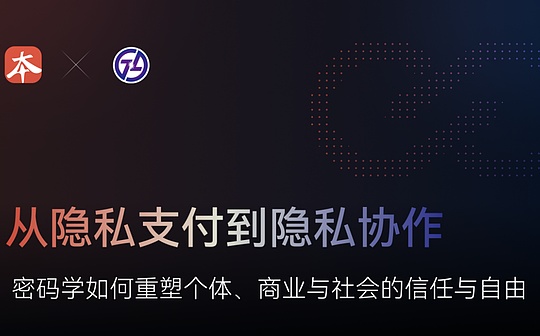
Author: YBB Capital Researcher Ac-Core
Important points
-
Founded by the Trump family and top crypto industry figures, World Liberty Financial is gradually affecting the direction of the industry, and their recent token buying behavior has also driven the price increase in secondary markets.
-
After Trump’s victory, key cryptocurrency favorable policies in the short term include: establishing strategic Bitcoin reserves in the United States, legalizing cryptocurrencies, and supporting debt plans through issuing ETFs.
-
The new interest rate cut will attract more funds into DeFi, creating a macro environment similar to the DeFi summer in 2020-2021.
-
DeFi lending agreements such as AAVE and Hyperliquid are attracting widespread attention and show strong recovery and explosiveness.
-
Binance and Coinbase recently favored DeFi-related tokens in their listing trends.
1. External factors affecting the overall trend:
1.1 World Libertyfi and the Trump Administration

Image source: Financial Times
World Liberty Financial is positioned as a decentralized financial platform that provides fair, transparent and compliant financial tools.It attracted a large number of users and symbolized the beginning of the banking revolution.Founded by the Trump family and top figures in the crypto industry, the platform aims to challenge the traditional banking system by providing innovative financial solutions.This reflects Trump’s ambition to challenge the traditional banking system by providing innovative solutions to make the United States a global leader in cryptocurrencies.
Recently, World Liberty Financial’s purchase behavior in December had an impact on the market, resulting in a rebound in prices of several DeFi tokens including ETH, cbBTC, LINK, AAVE, ENA and ONDO.
1.2 Trump expects to introduce cryptocurrency-friendly policies after he takes office
The 47th President of the United States, Donald Trump, will take office on January 20, 2025, and the crypto favorable policies expected to be implemented during his administration include:
-
Trump reiterates plans to build US Bitcoin strategic reserves
Strategic reserves are key resources to be released in the event of a crisis or supply disruption.A well-known example is the US strategic oil reserves.Trump recently said the U.S. plans to take major action in the crypto space, potentially creating a cryptocurrency reserve similar to that of oil reserves.According to CoinGecko data in July this year, governments hold 2.2% of the global Bitcoin supply, with the United States holding 200,000 BTC worth more than $20 billion.
-
The normalization of cryptocurrency legalization
With the second Trump administration coming to power, cryptocurrencies may go full legalization.There may be more open policies in this area.At the Blockchain Association’s annual event, Trump expressed support for efforts to pass U.S. cryptocurrency legislation and acknowledged that practical use cases like DePIN would legalize cryptocurrencies and become a priority on the legislative agenda.He promises to ensure Bitcoin and cryptocurrencies prosper in the United States
-
Crypto Game of Thrones: Strengthening Dollar Dominance + Bitcoin Reserve + Crypto Legalization + ETF = Bonds
Trump has publicly supported the view that crypto assets have many benefits, including: 1) Strengthening the US dollar’s status and the pricing power of cryptocurrencies against the US dollar; 2) Preemptively deploying in the crypto market to attract more capital; 3) ForceThe Federal Reserve is allied with him; 4) Promote the previous hostile capital to form an alliance with him.
As shown in the figure below, the US dollar index was around 80 in 2014, when U.S. debt was about $20 trillion.Today, U.S. debt has increased to about $36 trillion, an increase of 80%, but the dollar continues to rise abnormally.If the US dollar continues to strengthen, coupled with the SEC’s approval of Bitcoin spot ETFs, the new increment can fully cover future bond issuance costs.

Image data source: Investing
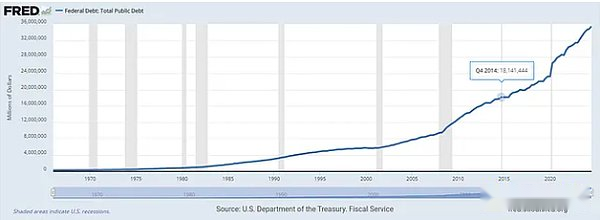 Image data source: fred.stlouisfed
Image data source: fred.stlouisfed
1.3 The new round of interest rate cuts make DeFi more attractive
Data from the U.S. Bureau of Labor Statistics showed that core inflation rose 0.3% for the fourth consecutive quarter in November, up 3.3% year-on-year.Housing costs have eased, but commodity prices, excluding food and energy, rose 0.3%, the biggest increase since May 2023.
The market responded quickly, raising the probability of the Fed’s interest rate cut next week from 80% to 90%.Investment manager James Assy believes that the December rate cut is almost certain.JPMorgan Chase also expects the Federal Reserve to start quarterly cuts after its December policy meeting until the federal funds rate reaches 3.5%.
The revival of DeFi is driven not only by internal factors but also by key external economic changes.As global interest rates change, high-risk assets such as DeFi and cryptocurrencies are becoming increasingly attractive to investors seeking higher returns.The market is preparing for a period of potentially sustained low interest rates, similar to the cryptocurrency bull market in 2017 and 2020.
Therefore, DeFi benefits in a low interest rate environment for two reasons:
1. Reduce capital opportunity cost: As the yields of traditional financial products fall, investors may turn to DeFi for higher returns (also means that the potential profit margins in the crypto market will be compressed).
2. Reduce lending costs: Cheaper financing encourages lending and promotes the activity of the DeFi ecosystem.
After two years of adjustment, key indicators such as TVL have begun to rebound.The transaction volume of the DeFi platform has also increased significantly.

Image data source: DeFiLlama
2. On-chain growth drives market trends
2.1 Restoration of the lending agreement AAVE

Image source: Cryptotimes
The architectures of AAVE V1, V2, and V3 are basically the same, but the key upgrade of V4 is the introduction of the “unified liquidity layer”.This feature is an extension of the Portal concept introduced in AAVE V3.Portal is a cross-chain function in V3, aiming to achieve cross-chain asset supply, but many users are not familiar with or have never used it.Portal’s purpose is to bridge assets between different blockchains by minting and destroying aToken across chains.
For example, Alice holds 10 aETH on Ethereum and wants to transfer it to Arbitrum.She can submit transactions through a whitelist bridge protocol, which will perform the following steps:
-
The contract on Arbitrum temporarily minted 10 aETH without any underlying assets.
-
These aETHs are transferred to Alice.
-
The batch process bridges the actual 10 ETH to the Arbitrum.
-
Once funds are in place, these ETHs are injected into the AAVE pool to support the minted aETH.
Portal allows users to transfer funds across chains in pursuit of higher deposit rates.Although Portal implements cross-chain liquidity, its operation relies on the whitelist bridge protocol rather than the core protocol of AAVE, and users cannot use this feature directly through AAVE.
This is improved by the “Unified Liquidity Layer” in V4, using modular design to manage supply, lending limits, interest rates, assets and incentives to achieve dynamic and more efficient allocation of liquidity.Additionally, the modular design enables AAVE to easily introduce or delete new modules without the need for large-scale liquidity migration.
With Chainlink’s Cross-chain Interoperability Protocol (CCIP), AAVE V4 will also build a “cross-chain liquidity layer” that enables users to instantly access all liquidity resources across different networks.Through these improvements, Portal will evolve into a complete cross-chain liquidity protocol.
In addition to the “Unified Liquidity Layer,” AAVE V4 plans to launch new features including dynamic interest rates, liquidity premiums, smart accounts, dynamic risk parameter configurations and expansion to non-EVM ecosystems, with stablecoins GHO and AAVE lending protocols asThe core of Aave network.
As a leader in DeFi, AAVE has accounted for about 50% of the market share over the past three years.The launch of V4 is intended to further expand its ecosystem to serve a potential user base of 1 billion.
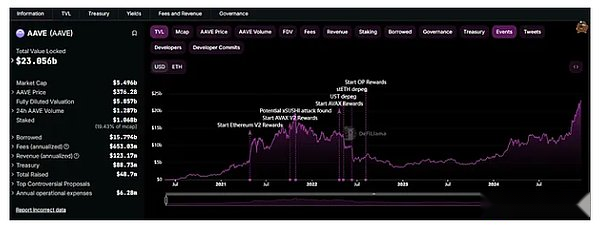
Image data source: DeFiLlama
As of December 18, 2024, AAVE’s TVL saw significant growth, surpassing the 2021 DeFi summer peak level by 30%, reaching $23.056 billion.Compared with the previous round, the changes in this round of DeFi protocol focus more on modular lending and improving funding efficiency.(For more details about the modular lending agreement, please refer to our previous article “Derivatives of Modular Narrative: Modular Evolution of DeFi lending”)
2.2 The strongest derivative dark horse of the year: Hyperliquid

Image source: Medium: Hyperliquid
According to Yunt Capital (@stevenyuntcap), the sources of revenue of the Hyperliquid platform include instant listing and auction fees, HLP market makers’ profits and losses, and platform fees.The first two are public information, and the team recently explained the third source of revenue.Based on this, we can estimate that Hyperliquid’s total revenue from the beginning of the year to the present is approximately US$44 million, of which HLP contributed US$40 million.HLP Strategy A lost $2 million, while Strategy B made $2 million.Liquidation revenue was US$4 million.When the HYPE token was launched, the team repurchased HYPE tokens from the market through the aid fund wallet.Assuming the team does not have other USDC AF wallets, the USDC AF profit and loss from year to date is $52 million.
So, with HLP’s $44 million and USDC AF’s $52 million, Hyperliquid’s total revenue from year to date is about $96 million, surpassing Lido to become the ninth largest cryptocurrency project in 2024.
Messari Research’s @defi_monk recently conducted a valuation study on HYPE tokens.Its FDV is about $13 billion, which may exceed $30 billion under the right market conditions.In addition, Hyperliquid plans to launch HyperEVM through its TGE, and more than 35 teams are expected to participate in the new ecosystem, bringing Hyperliquid closer to becoming the universal Layer 1 blockchain, rather than just the application chain.
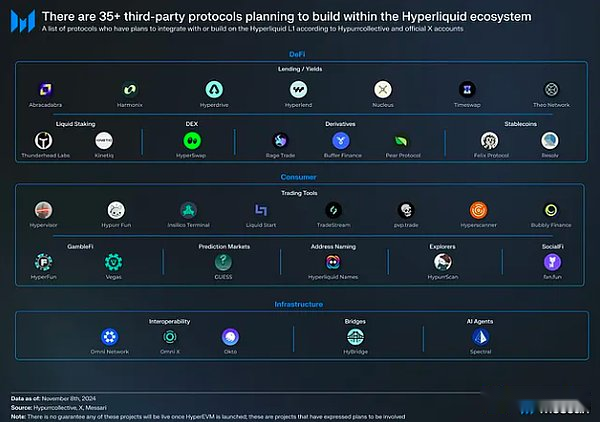
Image source: Messari
Hyperliquid should adopt a new valuation framework.Typically, killer applications are separate from their Layer 1 networks.Revenue from the application is the application token, while revenue from the Layer 1 network is the network validator.However, Hyperliquid integrates these revenue streams.Therefore, Hyperliquid not only has a leading decentralized perpetual contract trading platform (Perp DEX), but also controls its underlying Layer 1 network.We use segment sum valuations to reflect their vertical integration characteristics.First, let’s take a look at the valuation of Perp DEX.
Messari’s overall view of the derivatives market is consistent with Multicoin Capital and ASXN, with one exception – Hyperliquid’s market share.The Perp DEX market is a “winner-takes-all” market for the following reasons:
-
Any Perp DEX can launch any perpetual contract, eliminating the problem of blockchain fragmentation.
-
Unlike centralized exchanges, decentralized exchanges do not require a license.
-
There is a network effect in terms of order flow and liquidity.
In the future, Hyperliquid’s dominance will continue to grow.Hyperliquid expects to occupy nearly half of the on-chain market share by 2027, generating $551 million in revenue.Currently, transaction fees belong to the community and are therefore considered actual income.Based on the 15 times multiple of the DeFi valuation standard, Perp DEX, as an independent business, is valued at US$8.3 billion.For enterprise customers, you can refer to our complete model.Now let’s take a look at L1 valuation:
Typically, the valuation of L1 is evaluated using the premium of the DeFi application running on it.As Hyperliquid’s activity on its network continues to increase, its valuation may rise further.Hyperliquid is currently the 11th-ranked blockchain for TVL.Similar networks, such as Sei and Injective, are valued at $5 billion and $3 billion, respectively, while high-performance networks of similar scales such as Sui and Aptos are valued at $30 billion and $12 billion, respectively.
As HyperEVM is not available yet, Hyperliquid’s L1 valuation is conservatively estimated to have a premium of $5 billion.But based on current market prices, the L1 valuation could be close to $10 billion or even higher.
So, in the base case, Hyperliquid’s Perp DEX is valued at $8.3 billion and its L1 network is valued at $5 billion, bringing its total FDV to about $13.3 billion.In a bear market, its valuation is about $3 billion, while in a bull market, its valuation may reach $34 billion.
3. Conclusion
Looking ahead to 2025, the comprehensive recovery and soaring of the DeFi ecosystem will undoubtedly become the mainstream narrative.With the Trump administration’s policy support for decentralized finance, the US cryptocurrency industry has ushered in a more favorable regulatory environment, and DeFi is ushering in unprecedented innovation and growth opportunities.As the leader of lending agreements, AAVE has gradually recovered and surpassed its former glory with the innovation of liquidity layer in V4, becoming the core force in the DeFi lending field.At the same time, in the derivatives market, Hyperliquid has rapidly risen to become the strongest dark horse in 2024, attracting a large number of users and liquidity with its outstanding technological innovation and efficient market share integration.
At the same time, the listing strategies of mainstream exchanges such as Binance and Coinbase are also constantly evolving, and DeFi related tokens have become a new focus, such as ACX, ORCA, COW, CETUS, VELODROME, etc., which have been launched recently, the actions of the two major platforms are reflected.The market’s confidence in DeFi.
The prosperity of DeFi is not limited to the lending and derivatives markets, but will also blossom in areas such as stablecoins, liquidity supply, and cross-chain solutions.It can be foreseeable that, driven by policy, technology and market forces, DeFi will rise again in 2025 and become an indispensable part of the global financial system.

